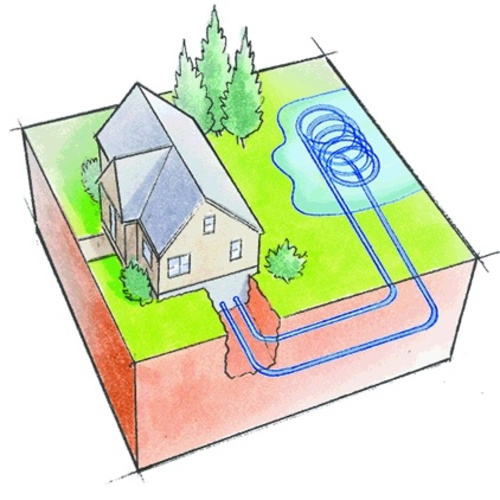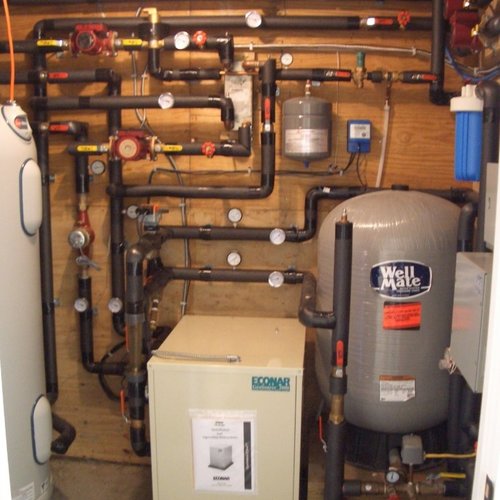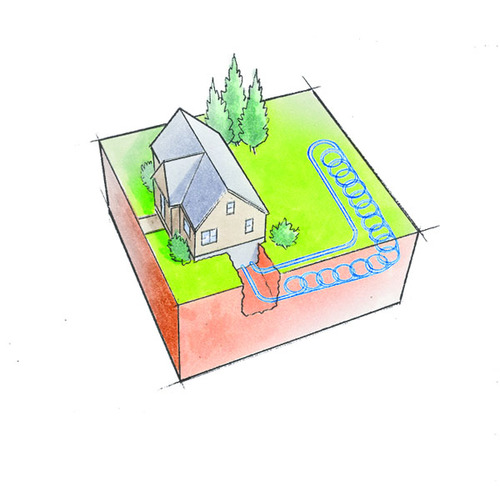
Ground source heat pump (GSHP) systems collect ambient heat from the soil within 400 feet of the ground surface. This heat is concentrated by vapor-compression refrigeration units and delivered to conditioned spaces by conventional forced-air or hydronic mechanical systems. They reverse this process when in cooling mode. The technology has been used since the 1950s, so there are few unknowns. It works in nearly any climate or soil condition, and no longer needs to be proven. GSHP efficiencies are multiples of conventional HVAC equipment conversion. Heating coefficients of performance (COP) for GSHP systems range from 2.7 to as much as 5.0, while cooling energy-efficiency ratios (EERs) range from 13 to 27.
You don’t have to burn fossil fuels
GSHPs use electric power to run the compressor, loop-circulating pump, and fan; there is no combustion or conversion of chemical energy to thermal energy. On average, a GSHP uses about 1 kW of grid power per ton of capacity (12,000 Btu/hour). A kilowatt of electricity equals 3,413 Btu, so this means a COP of about 3.5.
Assuming that natural gas costs $1.25 per therm, a GSHP with a COP of 3.5 will cost less to operate than a 90% AFUE gas furnace unless electricity costs more than 16.5¢ per kWh—significantly higher than the national average electric rate of about 10¢ per kWh. When you compare lower maintenance needs of noncombustion GSHP machines with combustion units (especially as they age), the annual out-of-pocket advantage grows. A GSHP also eliminates the need for a separate air-conditioning system and its associated costs.
It’s true that the initial cost of a residential GSHP system is usually two or three times that of a conventional HVAC system. A GSHP is an upgrade, just like custom fixtures and furnishings elsewhere in the home. However, operating costs are routinely one-half to one-fourth those of conventional equipment, as are recurring maintenance costs, while the equipment service life is typically twice as long—25 to 30 years. These economic advantages result in part from the efficiency of the technology and in part from good design practices that emphasize properly sized equipment. A new-construction installation is more cost effective than a retrofit.
A GSHP pays for itself quickly
The typical payback period for the incremental cost of a GSHP system is three to eight years, which gives a GSHP a significant life-cycle cost advantage over conventional equipment. When the time comes to replace a GSHP, the ground loop remains available for use by the replacement equipment.
Owners of GSHP systems will see savings each time they pay their
monthly electric bill. With heating and cooling costs reduced by half or more, funds become available to pay other expenses. At some point—in two, five, or 10 years—the GSHP premium is exceeded by savings, and net benefits accrue. Before and after that point, users will enjoy improved comfort and environmental benefits, as well as safer, more efficient, and more reliable equipment.
GSHPs harness renewable energy that is available anywhere and make
the energy available to anyone on any scale. Once installed, the equipment is unobtrusive. While some of the energy delivered by a GSHP comes from the electrical grid, most comes from the earth as free and sustainable energy. GSHPs work as promised and are available now.
Weekly Newsletter
Get building science and energy efficiency advice, plus special offers, in your inbox.














3 Comments
Not just a little biased... A
Not just a little biased... A LOT biased. I know of a 1500sf superinsulated home that's costing $200/mo electicity to heat, that about a 75 year pay back.
Also, the electrical supply here in coastal Maine comes from 80%carbon based generation!!!!!!!!!!!!!!
Not just a little biased....
I know of a gas furnace that didn't work right either because the installer put the fan in backwards. So what's your point, anonymous? Bad workmanship and no quality assurance can happen in any industry. one of the real problems though is that there's no quality assurance (though there is an "International" association masquerading as a quality assurance organization) at all. Check if anyone has ever tried to get recourse for a bad design / installer anywhere in the 50 states, and how far they've gotten. The manufacturers just put up a lawyer's hand....reason enough for everyone to stay away from GSHP, until the monkeys get their act together. It's too bad too because this really is a great technology when done right.
ground source heat pump in a cooling mode
Greetings
I’m try to design a cooling system using ground source heat pump to cool a house from 41 degrees to 21 degrees in summer, the summer temperatures ranges from 36 to 42 degrees. Could you please detail me with the following?
1. Operation theory
1. type of refrigerants, is water possible
2. design of the horizontal layer out
3. heat exchangers materials
4. pump type and size
Regards
Mothusi Maswe
Log in or create an account to post a comment.
Sign up Log in